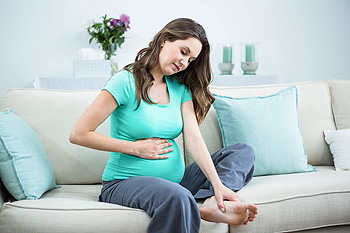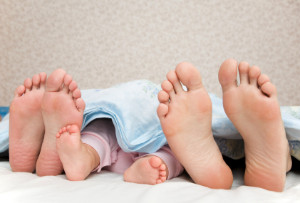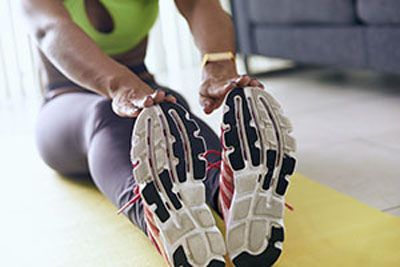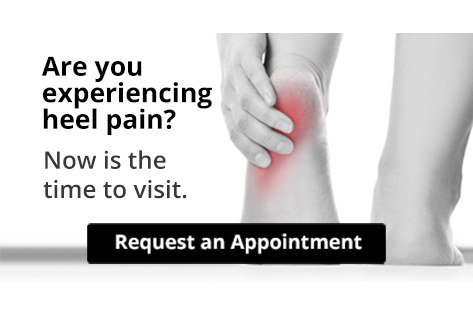Connect With Us
Blog
Items filtered by date: May 2021
Swollen Feet During Pregnancy Is Common
 Many women often feel the effects of their pregnancy in their feet. Sometimes the face, hands, and legs become swollen too, but most commonly the feet and ankles are affected, and all this swelling is known as edema. It is generally caused by the growing fetus in addition to the extra body fluids that often accompany pregnancy. Many women experience swollen feet and ankles in the second trimester, and this may continue to progress throughout the pregnancy. It can be beneficial to elevate the feet as frequently as possible, in addition to eating foods that have low sodium levels. Research has indicated it can help to limit the amount of time standing or walking and drinking 12 cups of water daily has been known to reduce a portion of the swelling. If you have questions about how pregnancy can affect the feet, please consult with a podiatrist.
Many women often feel the effects of their pregnancy in their feet. Sometimes the face, hands, and legs become swollen too, but most commonly the feet and ankles are affected, and all this swelling is known as edema. It is generally caused by the growing fetus in addition to the extra body fluids that often accompany pregnancy. Many women experience swollen feet and ankles in the second trimester, and this may continue to progress throughout the pregnancy. It can be beneficial to elevate the feet as frequently as possible, in addition to eating foods that have low sodium levels. Research has indicated it can help to limit the amount of time standing or walking and drinking 12 cups of water daily has been known to reduce a portion of the swelling. If you have questions about how pregnancy can affect the feet, please consult with a podiatrist.
Pregnant women with swollen feet can be treated with a variety of different methods that are readily available. For more information about other cures for swollen feet during pregnancy, consult with one of our podiatrists from Family Foot and Ankle Care of Moriches. Our doctors will attend to all of your foot and ankle needs.
What Foot Problems Can Arise During Pregnancy?
One problem that can occur is overpronation, which occurs when the arch of the foot flattens and tends to roll inward. This can cause pain and discomfort in your heels while you’re walking or even just standing up, trying to support your baby.
Another problem is edema, or swelling in the extremities. This often affects the feet during pregnancy but tends to occur in the later stages.
How Can I Keep My Feet Healthy During Pregnancy?
- Wearing orthotics can provide extra support for the feet and help distribute weight evenly
- Minimize the amount of time spent walking barefoot
- Wear shoes with good arch support
- Wear shoes that allow for good circulation to the feet
- Elevate feet if you experience swelling
- Massage your feet
- Get regular, light exercise, such as walking, to promote blood circulation to the feet
If you have any questions please feel free to contact our offices located in Moriches and Shirley, NY . We offer the newest diagnostic and treatment technologies for all your foot and ankle needs.
Congenital Foot Deformities
 When a baby is born, people will sometimes use the expression “10 fingers and 10 toes” to reference the newborn’s good health. But what if there is a problem with those 10 (or more) toes? Congenital foot deformities are differences in the structure of a baby’s feet that are present from birth. Fortunately, most of these conditions are treatable and do not cause any serious complications. Clubfoot is a deformity in which the baby’s feet are twisted inwards at the ankle. This generally does not cause any pain, but may interfere with walking later on. It can be corrected through a series of braces and casts. Metatarsus adductus is a common deformity in which part of the child’s foot turns inwards. Most cases resolve on their own, and stretching exercises or casts and orthotics can help those that don’t. Polydactyly is a mutation in which the baby has extra toes. Treatment will depend on the location and functionality of the extra toes, but may include surgery once the child is a little bit older. If you have any concerns about your baby’s foot health please consult with a podiatrist.
When a baby is born, people will sometimes use the expression “10 fingers and 10 toes” to reference the newborn’s good health. But what if there is a problem with those 10 (or more) toes? Congenital foot deformities are differences in the structure of a baby’s feet that are present from birth. Fortunately, most of these conditions are treatable and do not cause any serious complications. Clubfoot is a deformity in which the baby’s feet are twisted inwards at the ankle. This generally does not cause any pain, but may interfere with walking later on. It can be corrected through a series of braces and casts. Metatarsus adductus is a common deformity in which part of the child’s foot turns inwards. Most cases resolve on their own, and stretching exercises or casts and orthotics can help those that don’t. Polydactyly is a mutation in which the baby has extra toes. Treatment will depend on the location and functionality of the extra toes, but may include surgery once the child is a little bit older. If you have any concerns about your baby’s foot health please consult with a podiatrist.
Making sure that your children maintain good foot health is very important as they grow. If you have any questions, contact one of our podiatrists of Family Foot and Ankle Care of Moriches. Our doctors can provide the care you need to keep you pain-free and on your feet.
Keeping Children's Feet Healthy
Having healthy feet during childhood can help prevent medical problems later in life, namely in the back and legs. As children grow, their feet require different types of care. Here are some things to consider...
Although babies do not walk yet, it is still very important to take care of their feet.
Avoid putting tight shoes or socks on his or her feet.
Allow the baby to stretch and kick his or her feet to feel comfortable.
As a toddler, kids are now on the move and begin to develop differently. At this age, toddlers are getting a feel for walking, so don’t be alarmed if your toddler is unsteady or ‘walks funny’.
As your child gets older, it is important to teach them how to take care of their feet.
Show them proper hygiene to prevent infections such as fungus.
Be watchful for any pain or injury.
Have all injuries checked by a doctor as soon as possible.
Comfortable, protective shoes should always be worn, especially at play.
If you have any questions please feel free to contact our offices located in Moriches and Shirley, NY . We offer the newest diagnostic and treatment technologies for all your foot and ankle needs.
What to Do When the Sweat on Your Feet Doesn’t Go Away
 Normal sweating is your body’s way of regulating its temperature, and is triggered by a rise in temperature or physical exertion. Hyperhidrosis is characterized by excessive sweating that occurs when none of these factors are present. There are two types of hyperhidrosis: primary—which is the most common and typically appears on specific parts of the body including the feet, and secondary—which can be caused by certain medications, or an underlying medical condition. Excessive dampness of the feet may not only be embarrassing and uncomfortable, but it may even lead to athlete’s foot, odor from bacteria, and a breaking down of the skin. If you find that your feet are continuously wet throughout the day, contact a podiatrist who can examine you to see if hyperhidrosis is present, and use a variety of therapies and medicines to help manage it.
Normal sweating is your body’s way of regulating its temperature, and is triggered by a rise in temperature or physical exertion. Hyperhidrosis is characterized by excessive sweating that occurs when none of these factors are present. There are two types of hyperhidrosis: primary—which is the most common and typically appears on specific parts of the body including the feet, and secondary—which can be caused by certain medications, or an underlying medical condition. Excessive dampness of the feet may not only be embarrassing and uncomfortable, but it may even lead to athlete’s foot, odor from bacteria, and a breaking down of the skin. If you find that your feet are continuously wet throughout the day, contact a podiatrist who can examine you to see if hyperhidrosis is present, and use a variety of therapies and medicines to help manage it.
If you are suffering from hyperhidrosis contact one of our podiatrists of Family Foot and Ankle Care of Moriches. Our doctors can provide the care you need to attend to all of your foot and ankle needs.
Hyperhidrosis of the Feet
Hyperhidrosis is a rare disorder that can cause people to have excessive sweating of their feet. This can usually occur all on its own without rigorous activity involved. People who suffer from hyperhidrosis may also experience sweaty palms.
Although it is said that sweating is a healthy process meant to cool down the body temperature and to maintain a proper internal temperature, hyperhidrosis may prove to be a huge hindrance on a person’s everyday life.
Plantar hyperhidrosis is considered to be the main form of hyperhidrosis. Secondary hyperhidrosis can refer to sweating that occurs in areas other than the feet or hands and armpits. Often this may be a sign of it being related to another medical condition such as menopause, hyperthyroidism and even Parkinson’s disease.
In order to alleviate this condition, it is important to see your doctor so that they may prescribe the necessary medications so that you can begin to live a normal life again. If this is left untreated, it is said that it will persist throughout an individual’s life.
A last resort approach would be surgery, but it is best to speak with your doctor to find out what may be the best treatment for you.
If you have any questions please feel free to contact our offices located in Moriches and Shirley, NY . We offer the newest diagnostic and treatment technologies for all your foot and ankle needs.
Heel Pain Can Be Treated!
Causes and Preventative Methods for Cracked Heels
Cracked  heels are a common foot problem that can affect up to one in five adults. While cracked heels aren’t usually a big issue for most, they can lead to discomfort and severe pain. There are a variety of factors that can lead to cracked heels. These include standing for long periods of time, walking barefoot, using harsh soaps, dry skin from the climate, and shoes that don’t support the heels. Medical causes such as a vitamin deficiency, fungal infection, obesity, or pregnancy can also lead to cracked heels. In order to prevent cracked heels, make sure to wear shoes that properly support the heels by avoiding shoes with an open back, tall skinny heel, or shoes that are too tight. Staying hydrated, using a foot cream, avoiding standing in one place for a long period of time, and using custom shoe inserts are all ways to help prevent and treat cracked heels. If you have painful cracked heels, consulting with a podiatrist is suggested for a proper treatment method.
heels are a common foot problem that can affect up to one in five adults. While cracked heels aren’t usually a big issue for most, they can lead to discomfort and severe pain. There are a variety of factors that can lead to cracked heels. These include standing for long periods of time, walking barefoot, using harsh soaps, dry skin from the climate, and shoes that don’t support the heels. Medical causes such as a vitamin deficiency, fungal infection, obesity, or pregnancy can also lead to cracked heels. In order to prevent cracked heels, make sure to wear shoes that properly support the heels by avoiding shoes with an open back, tall skinny heel, or shoes that are too tight. Staying hydrated, using a foot cream, avoiding standing in one place for a long period of time, and using custom shoe inserts are all ways to help prevent and treat cracked heels. If you have painful cracked heels, consulting with a podiatrist is suggested for a proper treatment method.
If the skin on your feet starts to crack, you may want to see a podiatrist to find treatment. If you have any concerns, contact one of our podiatrists from Family Foot and Ankle Care of Moriches. Our doctors can provide the care you need to keep you pain-free and on your feet.
Cracked Heels
It is important to moisturize your cracked heels in order to prevent pain, bleeding, and infection. The reason cracked heels form is because the skin on the foot is too dry to support the immense pressure placed on them. When the foot expands, the dry skin on the foot begins to split.
Ways to Help Heal Them
- Invest in a good foot cream
- Try Using Petroleum Jelly
- Ease up on Soaps
- Drink Plenty of Water
Ways to Prevent Cracked Heels
- Moisturize After Showering
- Skip a Shower
- Keep Shower Water Lukewarm
- Don’t Scrub Your Feet
If you are unsure how to proceed in treating cracked heels, seek guidance from a podiatrist. Your doctor will help you with any questions or information you may need.
If you have any questions, please feel free to contact our offices located in Moriches and Shirley, NY . We offer the newest diagnostic and treatment technologies for all your foot care needs.
Blog Archives
- April 2024
- March 2024
- February 2024
- January 2024
- December 2023
- November 2023
- October 2023
- September 2023
- August 2023
- July 2023
- June 2023
- May 2023
- April 2023
- March 2023
- February 2023
- January 2023
- December 2022
- November 2022
- October 2022
- September 2022
- August 2022
- July 2022
- June 2022
- May 2022
- April 2022
- March 2022
- February 2022
- January 2022
- December 2021
- November 2021
- October 2021
- September 2021
- August 2021
- July 2021
- June 2021
- May 2021
- April 2021
- March 2021
- February 2021
- January 2021
- December 2020
- November 2020
- October 2020
- September 2020
- August 2020
- July 2020
- June 2020
- May 2020
- April 2020
- March 2020
- February 2020
- January 2020
- December 2019
- November 2019
- October 2019
- September 2019
- August 2019
- July 2019
- June 2019
- May 2019
- April 2019
- March 2019
- February 2019
- January 2019
- December 2018
- November 2018
- October 2018
- September 2018
- August 2018
- July 2018
- June 2018
- May 2018
- April 2018
- March 2018
- February 2018
- January 2018
- December 2017
- November 2017
- October 2017
- September 2017
- August 2017
- July 2017
- June 2017
- May 2017
- April 2017
- March 2017
- February 2017
- January 2017
- December 2016
- November 2016
- October 2016
- September 2016
- August 2016
- July 2016
- June 2016
- October 2015
- September 2015
- August 2015
- July 2015
- June 2015
- May 2015
- April 2015




